Historically
Gunpowder Treason and Plot
Gunpowder Treason and Plot
Couldn't load pickup availability
Sold out until next year.
Bonfire Night Remembrance.
Ignite the spirit of Guy Fawkes Night with this candle, whose scents of cade, cedarwood, and nutmeg encapsulate the essence of England’s most notorious evening. As the candle burns, its smoky cade aroma invokes the crackling bonfires that light up the November sky, while cedarwood reflects the enduring strength of British tradition. A hint of nutmeg adds a spicy warmth, reminiscent of the autumnal celebrations. This candle is a tribute to the night of intrigue and history, blending rich, natural scents that evoke the fiery determination and the festive gatherings that mark this historic event every year.
Share
Scent Notes
Scent Notes
cade, cedarwood, cypress & nutmeg
Delivery & Returns
Delivery & Returns
Dispatch times
Our candles are made to order and most will take between 1-7 business days to dispatch.
However, if you are wanting your order sooner or for a specific date please get in touch (via email or in the message box at checkout) and we can sort something out for you!
Delivery Times
We currently offer standard delivery with Royal Mail 2nd class which should arrive between 2-3 days after dispatch and Royal Mail 1st class which should arrive between 1-2 days after dispatch.
NOTE: Please note that during the months of November and December we use Royal Mail Tracked. This is more expensive than normal but we have found means that your parcels are safe and get to you in time.
Shipping outside the UK
We are more than happy to ship to America and Australia, unfortunately we cannot ship to the EU at this time.
If you would like an order to be delivered to Australia please do not hesitate to contact us via our contact page, email or Instagram message and we will calculate the shipping costs for you and complete your order via invoice.
Please note that customers are responsible for paying any import VAT, taxes and fees.
What is your return policy?
Please note earrings cannot be returned and refunded for hygiene reasons.
We are happy to accept returns if you are unhappy with your purchase.
Contact us within: 14 days of delivery
Dispatch items back within: 30 days of delivery
Request a cancellation within: 24 hours of purchase
Buyers are responsible for return postage costs. If the item is not returned in its original condition, the buyer is responsible for any loss in value.
Item damaged in transit
Sometimes accidents happen.
If you receive a parcel that has been damaged in the post please send a picture to us showing the damage within 48 hours of your parcel being delivered and we can discuss options with you. No worries.
Safety Information
Safety Information
Contains Terpinolene, beta-Pinene, delta-3-Carene, l-Limonene.
May produce an allergic reaction.
I. Keep candles away from curtains, fabrics, furniture, and draughts.
II. Avoid placing candles under shelves; maintain a 3-foot (1-meter) clearance above.
III. Prevent contact with clothes and hair; place candles out of reach.
IV. Keep children and pets at a distance from candles.
V. Maintain at least 4 inches (10cm) between burning candles.
VI. Extinguish before moving; avoid objects falling into hot wax.
VII. Never leave burning candles unattended.
VIII. Safely extinguish with a snuffer or spoon, not by blowing.
IX. Double-check to ensure candles are completely out.
Scent History
Scent History
Cade:
Cade (Juniperus oxycedrus), a Mediterranean juniper species, has been valued for centuries for its medicinal, aromatic, and practical uses. In ancient Greece and Rome, cade oil, extracted from the tree’s wood, was used to treat skin conditions such as eczema, psoriasis, and wounds, while the wood was often burned in rituals to purify the air and ward off evil spirits. During the Middle Ages, cade oil became a staple in European folk medicine, treating skin infections, parasites, and respiratory issues, as well as being used in veterinary care for livestock. Its smoky, leathery scent made it a popular ingredient in perfumes and incense due to its fragrance and antimicrobial properties. By the 19th and 20th centuries, cade oil was widely employed in dermatology, particularly in France, and today it remains valued in traditional medicine, cosmetics, and perfumery for its soothing, antiseptic qualities and distinctive aroma.
Cedar:
Cedar boasts a rich history spanning millennia, utilized by ancient civilizations like the Sumerians and Egyptians for construction and even embalming due to its durability and natural resistance to decay. It held biblical significance in the construction of Jerusalem's Temples, symbolizing strength and longevity. Native American tribes, especially in the Pacific Northwest, valued cedar for crafting canoes, totem poles, and longhouses. Cedar chests gained popularity in the 20th century for their ability to repel insects. Today, cedar remains cherished for its aroma, durability, and resistance to decay, serving as a valuable resource in construction, furniture, and woodworking, while its historical importance endures worldwide.
Cypress:
Cypress, with its fresh and woody scent, boasts an ancient history. Revered by civilizations like the Egyptians, Greeks, and Romans, the aroma of cypress, particularly the Cupressus species, held significance in various rituals. Egyptians used cypress in embalming, while Greeks associated it with mourning, planting it near cemeteries. Romans incorporated cypress into perfumes and cosmetics. Across the ages, cypress fragrance has maintained popularity in perfumery and aromatherapy, treasured for its refreshing and calming attributes. Today, it endures as a timeless scent, bridging the past and present with its soothing and invigorating olfactory allure.
Nutmeg:
Nutmeg, renowned for its warm and aromatic flavor, boasts a captivating history that spans centuries, marked by tales of exoticism and exploration. Indigenous to the Banda Islands of Indonesia, nutmeg was a closely guarded secret in ancient times, with its use dating back to as early as the 1st century AD when it traversed the Spice Route to reach the Middle East. During the Middle Ages, nutmeg held prestigious status in Europe, particularly within the Mediterranean region, though the origin of this spice remained enigmatic, often attributed to the work of magical creatures or birds from distant lands. This mystique prompted daring expeditions by European powers, such as the Portuguese and Dutch, who embarked on perilous voyages in pursuit of the elusive Spice Islands where nutmeg thrived. The 17th century witnessed the Dutch achieving a monopoly over nutmeg production, even resorting to the infamous Banda Massacre to maintain their dominance. Yet, in a bold endeavor, the French managed to clandestinely transport nutmeg trees to other tropical regions, effectively breaking the Dutch monopoly. Today, nutmeg retains its cherished status as a spice enhancing both sweet and savory dishes, with holiday recipes like eggnog and pumpkin pie prominently featuring its warm essence. The history of nutmeg weaves a captivating narrative of discovery, intrigue, and the relentless pursuit of culinary excellence across diverse cultures and epochs.






